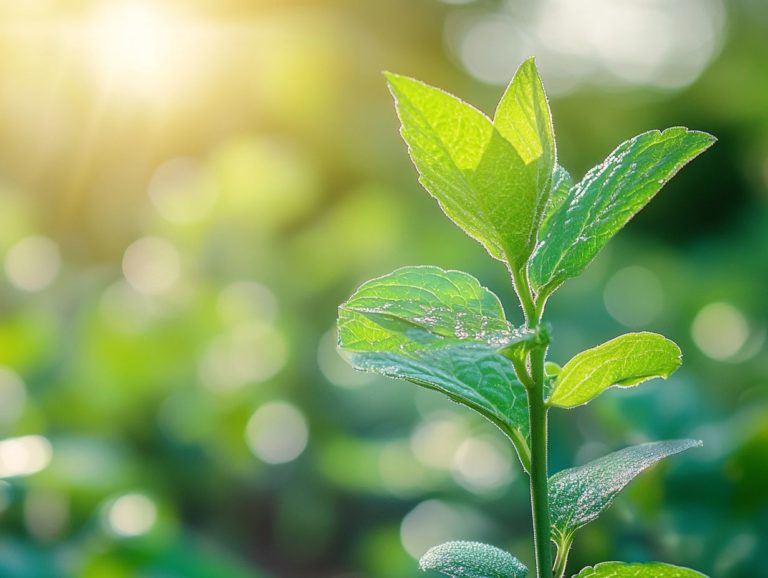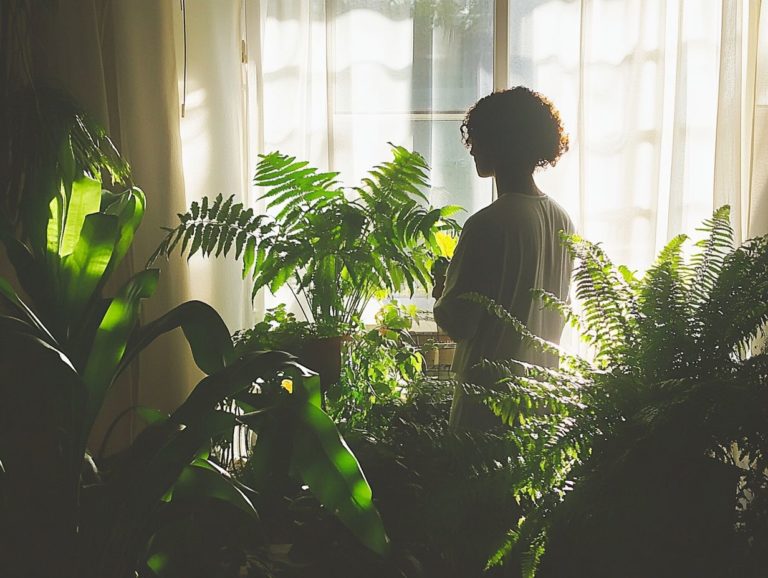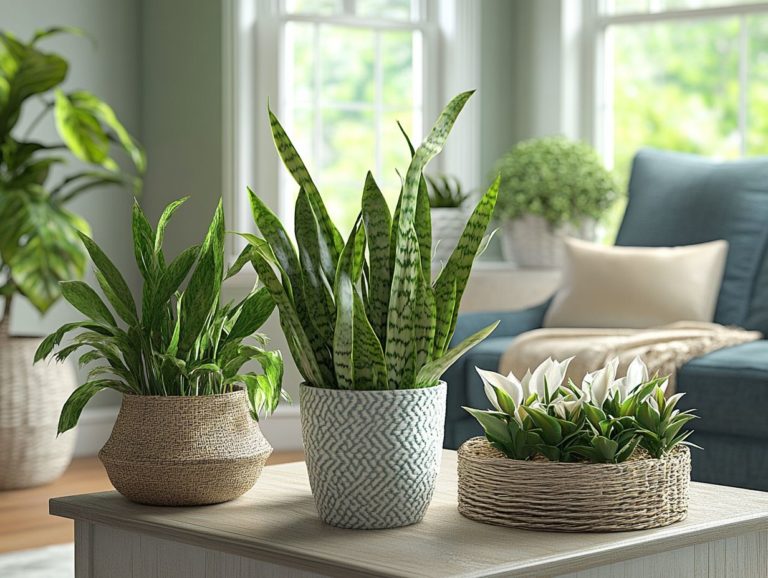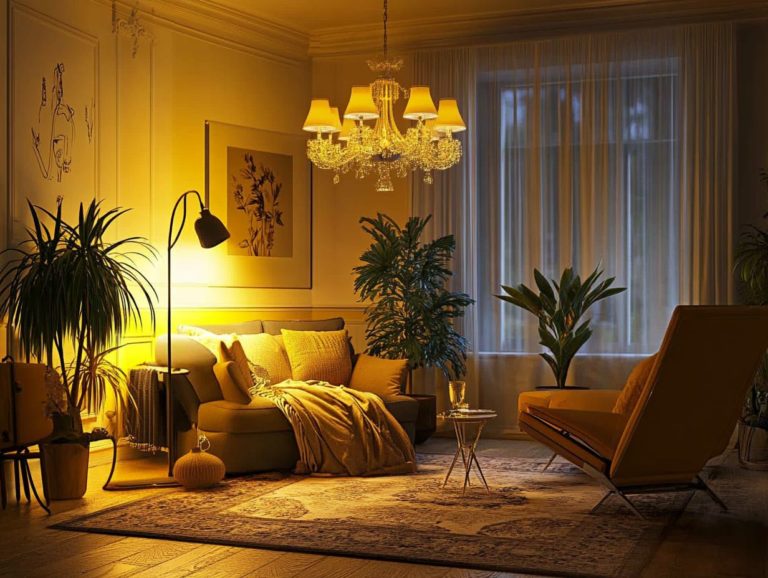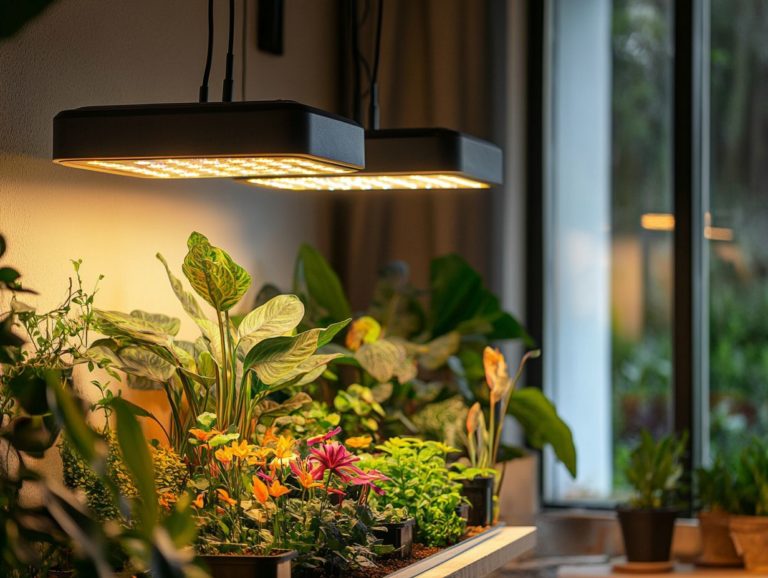Top 5 Shade-Tolerant Indoor Plants
Looking to illuminate your home without depending on that elusive sunlight? Get ready to discover amazing plants that will transform your space!
This article delves into the top five shade-tolerant indoor plants that flourish in low-light conditions. From the sophisticated Snake Plant to the hardy ZZ Plant, these selections not only beautify your space but also provide a myriad of benefits for your well-being.
You ll find insights on how to care for these plants, their adaptability, and even a few potential drawbacks. Immerse yourself and uncover the ideal plants for those snug corners of your home!
Contents
Key Takeaways:
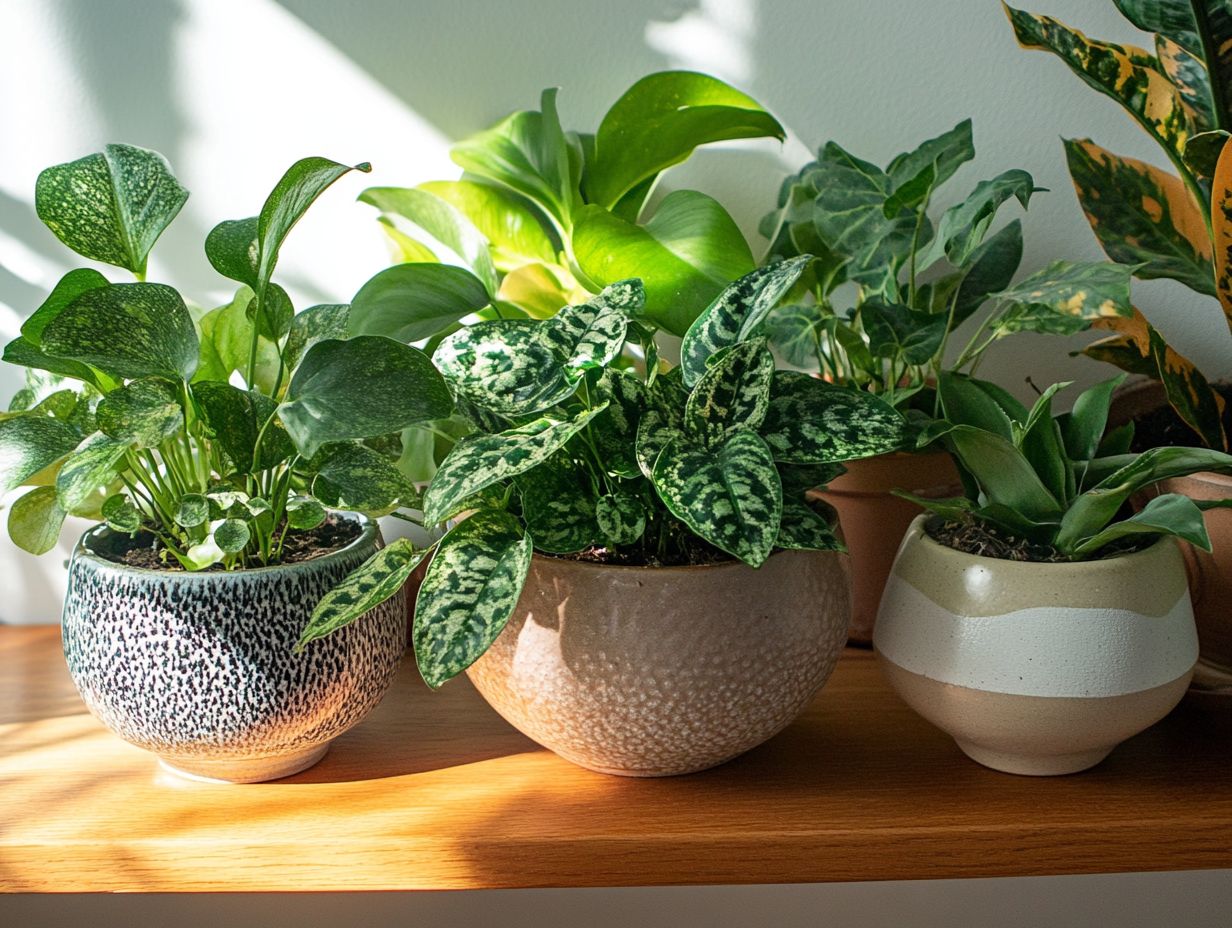
- Snake plants, peace lilies, ZZ plants, pothos, Chinese evergreens, and Kalanchoe are the top 5 shade-tolerant indoor plants.
- These plants have adapted to low-light conditions and provide multiple benefits, such as improving air quality and reducing stress.
- To care for these plants in low-light environments, water regularly and provide occasional fertilization.
1. Snake Plant
The Snake Plant, or Sansevieria, is a standout choice for your indoor spaces. Its striking dark green leaves and impressive ability to thrive in low-light conditions make it a perfect addition for anyone seeking minimal maintenance.
This hardy plant needs watering only every 2-6 weeks, depending on your environment. It prefers the soil to dry out between waterings. Aim for humidity levels around 30-50%. Placing it in areas with consistent airflow can support its growth.
It thrives in well-draining soil, like cactus mix or a blend with perlite, to help prevent root rot. Besides its visual appeal, the Snake Plant is renowned for its air-purifying prowess. It efficiently filters out harmful toxins and boosts oxygen levels, creating a healthier indoor atmosphere.
2. Peace Lily
The Peace Lily, known for its graceful white flowers and lush foliage, not only enhances your indoor spaces but also thrives in low-light environments. This makes it a go-to choice for anyone looking to beautify their home with minimal effort.
To ensure your Peace Lily thrives, position it where it receives bright, filtered light while avoiding direct sunlight, which can scorch its delicate leaves. Water regularly; allow the top inch of soil to dry out between waterings to help prevent root rot, a common issue with this plant.
Maintaining humidity levels between 40-60% will encourage vibrant foliage and regular blooming. If you notice yellowing leaves or brown tips, it may be due to overwatering or insufficient light. Adjusting these elements can work wonders. If you observe flower droop, check the moisture content and elevate the humidity to restore its vitality.
3. ZZ Plant
The ZZ Plant, with its glossy, dark green leaves and remarkable resilience, is the quintessential choice for your indoor spaces. It thrives in low-light conditions and demands minimal maintenance, making it perfect for busy individuals seeking stunning yet effortless decor.
This hardy plant prefers well-draining soil that retains some moisture while allowing it to dry out between waterings. Ideally, you ll want to water it every couple of weeks; however, it s quite forgiving if you happen to forget.
The ZZ Plant enjoys bright, indirect light but adapts well to fluorescent lighting, showcasing its versatility. Its resilience extends to various humidity levels, comfortably thriving in both dry and moderately humid environments. Plus, it purifies indoor air, transforming it from mere decoration into a functional ally for your living space.
Start your indoor garden today with these stunning shade-tolerant plants!
4. Pothos

Pothos, with its vibrant, cascading leaves, is an iconic indoor plant. It thrives effortlessly in low-light environments, making it a great choice for a decorative touch.
This resilient plant has unique growth habits. It can trail from a shelf or climb a trellis, adding a dynamic element to your space.
To keep the foliage lush and healthy, provide bright, indirect light. However, it adapts well to darker corners.
Stick to a consistent watering schedule. Allow the top inch of soil to dry out between waterings to prevent root rot.
Propagation is simple. Take cuttings with a few nodes, place them in water or soil, and watch new roots develop.
With proper care, this plant transforms your interior into a verdant oasis. It creates a green haven that promotes fresh air and well-being.
5. Chinese Evergreen
The Chinese Evergreen is a versatile indoor plant. It boasts stunning variegated leaves and thrives in low light.
This plant comes in several varieties. The popular Aglaonema ‘Silver Bay’ features striking silver-green foliage.
The ‘Red Siam’ variant stands out with its vibrant pink edges. Most varieties prefer indirect light, while a few tolerate brighter spots.
Water sparingly and allow the soil to dry out between sessions to prevent root rot.
Chinese Evergreens need a humidity level of at least 40%. Regular misting or a nearby humidifier can help.
These plants not only look great but also purify the air. They make a valuable addition to your home.
What Makes These Plants Ideal for Low Light Environments?
Plants like the Snake Plant, Peace Lily, ZZ Plant, Pothos, and Chinese Evergreen are perfect for low-light environments. They thrive where sunlight is scarce, bringing greenery and easy maintenance to your spaces.
These plants have specialized leaf structures. They often have larger surface areas that capture even the faintest light.
Their photosynthesis processes have adapted to efficiently use minimal light. This ensures they flourish in dim conditions.
Adding these low-light champions to your home elevates its look and significantly improves air quality. They filter toxins and increase humidity, promoting a healthier atmosphere.
How Do These Plants Adapt to Low Light Conditions?
Plants like the Snake Plant and Peace Lily thrive in low-light conditions. They have traits that allow them to capture available light for photosynthesis.
These adaptations include larger leaf surfaces for better light absorption. Their slower growth rates help them conserve energy in low-light spaces.
These plants also have deeper root systems, accessing moisture and nutrients from further down in the soil. This enhances their resilience in indoor gardens.
Collectively, these traits empower low-light plants to flourish, transforming homes and offices into vibrant green spaces.
What Are the Benefits of Having Shade-Tolerant Plants in Your Home?
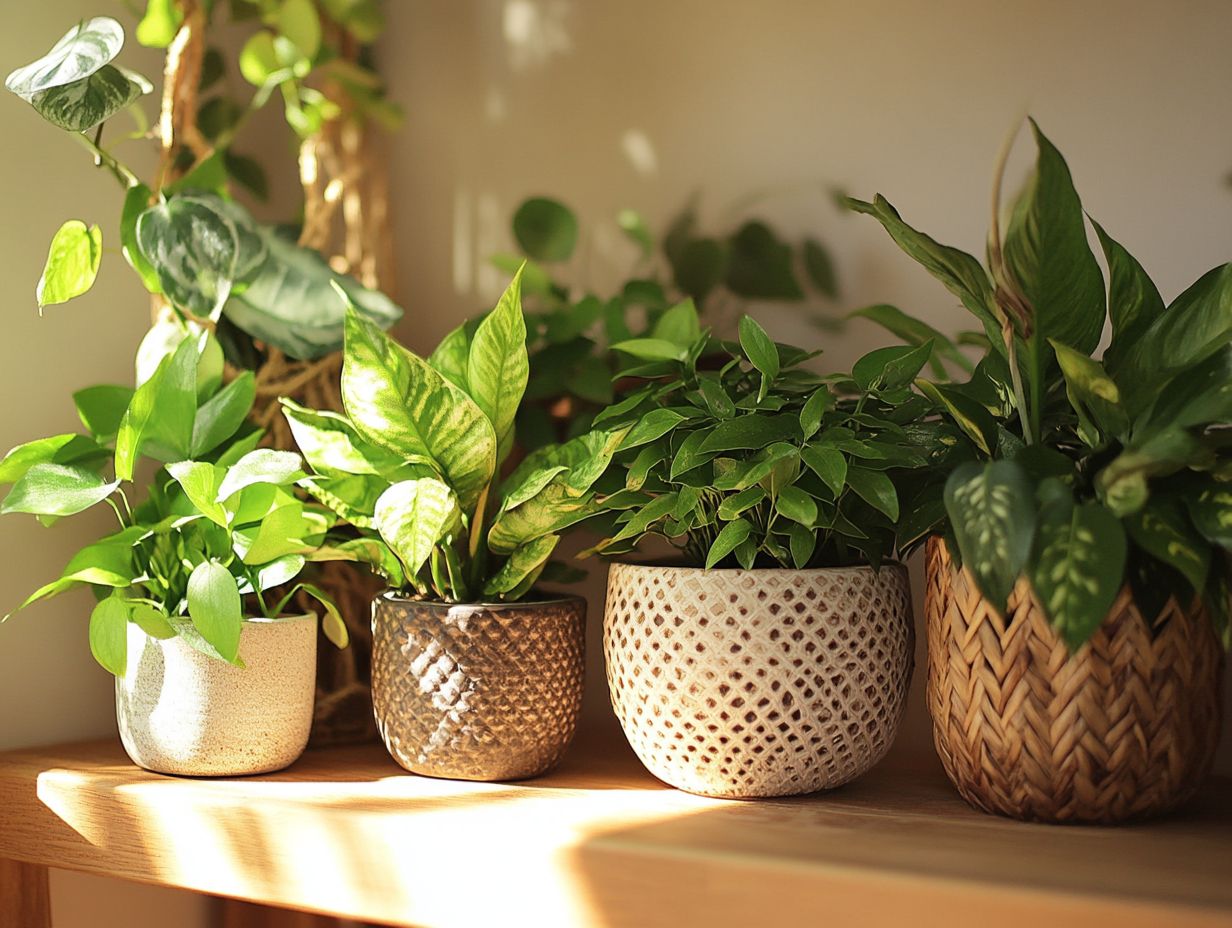
Adding shade-tolerant plants like Pothos, Spider Plants, and Chinese Evergreen to your home brings a host of advantages. Not only do these plants improve air quality, but they also elevate the aesthetic appeal of your space. They require less maintenance compared to traditional outdoor gardening perfect for your busy lifestyle.
These plants purify the air. They filter out harmful toxins and create a calming atmosphere that can lift your mood and promote relaxation. Their lush greenery serves as a stunning focal point, enhancing your decor and providing a refreshing touch that makes your indoor spaces feel more inviting.
Indoor plants help reduce stress. They allow you to connect with nature while at home. By incorporating such greenery, you can transform any area into a tranquil retreat that encourages mindfulness and enhances your overall well-being.
How Can These Plants Be Cared for in Low Light Environments?
Caring for low-light indoor plants like the Snake Plant and Peace Lily means getting to know their unique needs. This includes the right watering schedules, humidity levels, and soil conditions that will keep them thriving and healthy for years to come. You may also want to consider orchids and decorative Kalanchoe for added variety.
Establishing a dependable watering routine is essential; these plants like their soil to dry out a bit between drinks. A quick check of the top inch of soil can give you a good idea of moisture levels. Watch out for signs of overwatering giving them too much water can cause yellowing leaves or root rot, while underwatering might result in wilting or those pesky brown tips.
Keeping humidity levels around 40-60% will really help, especially for the Peace Lily. Using well-draining potting mixes is key; they should retain some moisture while preventing stagnant water. This creates the perfect environment for these resilient beauties to flourish in your indoor garden.
Are There Any Drawbacks to Having Shade-Tolerant Plants?
While shade-tolerant plants like the ZZ Plant, Chinese Evergreen, and Snake Plant are fantastic, they do have a few downsides. Slower growth rates and vulnerability to certain pests can crop up if these plants aren’t given the proper attention.
In low-light environments, their growth tends to stagnate, limiting those delightful blooms you re hoping for. Common pests, such as spider mites and mealybugs, might see these plants as an invitation, potentially leading to infestations that jeopardize their health and overall air quality.
To tackle these challenges head-on, it s crucial to regularly inspect your plants for any signs of pests and provide appropriate care. Occasional doses of diluted fertilizer can help stimulate growth, while neem oil serves as a natural pesticide to keep those pesky invaders at bay. Proper watering techniques and adequate humidity enhance their resilience and encourage lush, vibrant foliage in a low-maintenance environment.
Shade-tolerant plants can transform your home into a green oasis. Why wait? Start your indoor garden journey now!
What Are Some Other Options for Low Light Indoor Plants?
Along with the well-loved Snake Plant, Peace Lily, and Pothos, you ll discover an array of low-light indoor plants that can elevate your living space with minimal effort. Consider the Rubber Plant, Boston Fern, and Spider Plant as your new green companions.
Take the Rubber Plant, for instance. Its glossy leaves make a striking statement. It can grow quite tall, adding grandeur to any room.
It thrives in low to medium light and only asks for the occasional splash of water to maintain its vibrant appearance.
Then there’s the Boston Fern, which brings a lush, feathery texture that can transform your indoor environment. It enjoys a bit more humidity, making it an excellent fit for a bathroom or kitchen. This is especially true for those who appreciate decorative and leafy plants.
Don’t overlook the Spider Plant, known not just for its hardiness but also for its air-purifying prowess. Its charming offshoots also make it perfect for propagation (the process of creating new plants), making it a wonderful choice for anyone, whether you’re just starting your plant journey or looking for top indoor plants for varied lighting in a space with limited light.
These vibrant plants bring beauty and life to your space, all while being super easy to care for! They allow you to enjoy greenery effortlessly and improve your indoor air quality.
Frequently Asked Questions

1. What are the top 5 shade-tolerant indoor plants?
The top 5 shade-tolerant indoor plants are the ZZ Plant, snake plant, Pothos, Peace Lily, and Chinese Evergreen all excellent choices for enhancing your indoor environment.
2. How do I care for a ZZ plant?
ZZ plants thrive in low light and need watering just once a month. Be sure to allow the soil to dry out completely between waterings to avoid yellowing leaves.
3. Can I keep a snake plant in a dark corner?
Yes, snake plants can thrive in low light conditions and only need to be watered every 2-3 weeks. They also help purify the air in your home, making them a great addition for improving air quality.
4. What is the best way to care for a pothos plant?
Pothos plants do well in low to medium light and should be watered once a week. They also benefit from regular pruning to maintain their fullness, leading to beautiful, leafy growth.
5. How often should I water a peace lily?
Peace lilies prefer low to medium light and should be watered once a week, or when the top inch of soil is dry. They also appreciate occasional misting to increase humidity, which helps keep their vibrant flowers healthy.
6. Are Chinese evergreens safe for pets?
Yes, Chinese evergreens are non-toxic to cats and dogs. They can tolerate low light and only need to be watered every 1-2 weeks, making them a safe choice for pet owners.

